A Comprehensive Analysis of Farmland Prices in India: Trends and Insights

Overview
Investors have consistently shown interest in Indian farmland because of its real worth and sustained appreciation. Making wise investing decisions requires keeping track of price patterns throughout time. Government policies, the growth of organic farming, and urbanisation have greatly impacted farmland prices.
Historical Trends in Farmland Prices
Over the past 20 years, the price of farmland in India has steadily increased. Because of their closeness to major cities and the growth of agro-industrial zones, states like Tamil Nadu and Karnataka experienced notable growth. A further factor affecting valuation in the northern states was agricultural productivity in commodities like rice and wheat. However, because of development pressure, peri-urban areas have seen a faster rate of price acceleration than rural areas.
Key Regional Price Insights
Because of the rich soil and well-established agricultural infrastructure in North India, especially in Punjab and Haryana, farmland values are still high. These locations' proximity to urban areas increases the need for farmland. On the other hand, states like Rajasthan, despite their low costs, are gaining attention due to their innovative approaches to water management and renewable energy initiatives, which enhance the value of their land.
Due to industrialization and IT clusters, Tamil Nadu and Karnataka have the highest premium land costs in South India. Andhra Pradesh and Telangana, with their agricultural projects and irrigation advancements, offer more reasonable prices while still attracting investors. Regional characteristics such as market accessibility and climate greatly influence farmland prices.
Factors Influencing Farmland Values
Soil Fertility and Quality: Rich, usable soil makes land more valuable, especially in places where farming is the main industry. Poor soil quality could lead to a decrease in land prices.
Water Availability: Access to stable water sources, such as rivers, canals, or infrastructure for collecting rainwater, has a big effect on valuation.
Location and Accessibility: Prices tend to increase in close proximity to markets, transit hubs, and cities. In remote areas, prices may be lower, but they may not yield as much profit.
Climatic Conditions: Prices tend to be higher in places where the weather is favorable for a wide range of crops.
Legal Clearances: Clear titles and following zoning rules will make the property more valuable and in higher demand.
New developments in investments in farmland
More investors are looking for property that uses environmentally beneficial methods like organic farming and renewable energy. Higher long-term profitability is the outcome of these dynamics, which also correspond with the growing customer desire for sustainability.
Smart irrigation methods, IoT devices, and precision agriculture are revolutionizing traditional farming. Due to its potential for increased yield and efficiency, farmland with access to such innovations draws more investment interest.
Addressing Pricing Challenges
The price of property is often difficult to predict because of changes in demand, the weather, and the cost of inputs. To fix this, it's important to use a fair approach to valuation that looks at both past trends and what the future might hold.
Land laws and zoning rules can cause price differences. Clear rules and knowledge of the law can help reduce these problems, making sure that buyers and sellers get fair prices and building investor trust.
Conclusion
Economic, environmental, and social variables all influence farmland prices in India. With growing urbanization, new farming techniques, and increasing demand for organic food, farmland is still a good investment. Prospective investors should evaluate factors such as location, water availability, and soil quality in order to optimize profits and support sustainable agricultural development.
Latest blogs
JOIN OUR COMMUNITY !
Stay connected with Getfarms! Follow us on social media for the latest updates, exclusive offers, and a glimpse into the world of farmhouse living. Join our community today




























